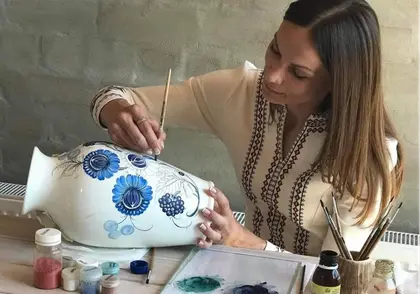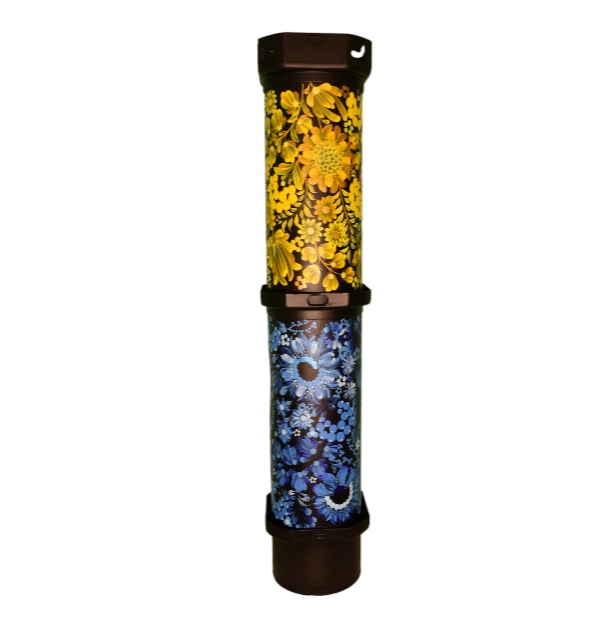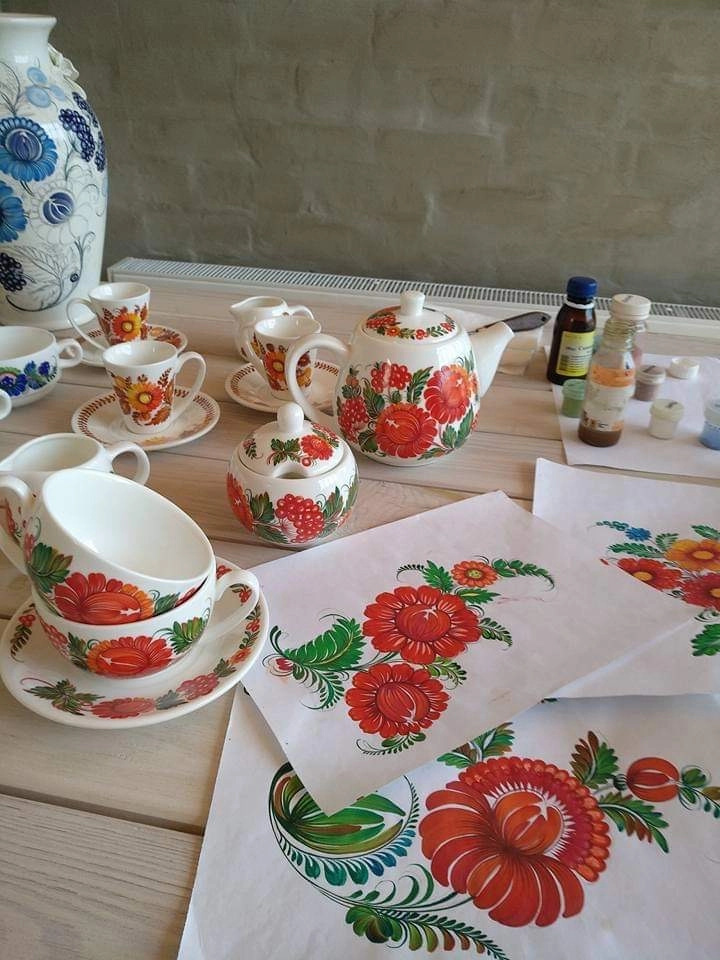Nataliia Pidhirnia-Babin is at work in her studio in Kyiv, meticulously crafting a painting in the traditional Petrykivka style, adding the final touches to a pair of stylized red flowers. They’re set against a stark black background, and the petals, painted in vibrant shades of orange and red, evoke the imagery of flames dancing against the darkness.
Utilizing a brush fashioned from a single cat hair, Pidhirnia-Babin creates intricate details with ease. Her brushstrokes are fluid and elegant, giving her painting a sense of motion and vitality. As a Petrykivka artist, she’s practicing an art form that has been part of Ukraine’s heritage and national identity for centuries.
JOIN US ON TELEGRAM
Follow our coverage of the war on the @Kyivpost_official.
Metal charge container for the M-777 NATO howitzer (USA). Author – Yana Koval (Ivano-Frankivsk). Petrykiv painting in the colors of the Ukrainian National Flag
She isn’t using a canvas
What’s remarkable about Nataliya’s “canvas” is, it’s not a true canvas: it’s actually the casing from a 24-inch-long artillery shell. Odds are, it was fired from a Russian self-propelled howitzer.

What Ukraine’s New Law on Religious Organizations Means
Other “canvases” that she and her fellow artists use include: fragments from downed Russian helicopters; ammunition boxes that once contained ordnance donated by the United States; and the 10-by-13-inch steel plates from military body armor.
Defiance, beauty, and hope
She and her artist friends consciously and deliberately turn remnants of war into objects of beauty. They’re using art as their way of resisting Putin’s efforts to demoralize their countrymen.
“Art itself is a form of resistance,” she points out. “It reminds us that when this horrible war is over, we will still have our identity. Art is our foundation, and with it, we will remember who we are, and we will be able to move on.”
She goes on to say: “In this War, we all want to do our part, and artists are working to preserve our culture. We want to remind our children where we came from. By sharing the centuries old Petrykivka art, we help keep in their hearts that Ukraine didn’t start in 1992 when we got our freedom from Russia.”
Vladyslav Alokhin, director of the National Museum-Preserve of Ukrainian Military Victory, shares Pidhirnia-Babin’s view on the importance of art for national survival. He knows that throughout history, art has been a medium through which oppressed or attacked communities assert their identity and resilience.
Ukrainian artists decorating shell casings offer a poignant example of this phenomenon.
The museum that he heads contains thousands of these war-related decorated objects.
While the works are inherently symbols of destruction and reminders of Russia’s war of aggression against Ukraine, in the Museum, they’re recontextualized through the lens of traditional Ukrainian Petrykivka art. They become a combination of defiance, beauty, and hope.
Alokhin makes sure that this message reaches the country’s young people. He arranges for traveling exhibits to be shown at schools, and the Museum hosts art classes for children where the kids get to paint the shell casings.
“When there’s an air raid,” he casually mentions, “if the kids aren’t already downstairs in the bomb shelter, they can run downstairs.”
Tea set with images of flowers and viburnum in the Petrykivsky style. The teapot and sugar bowl depict viburnum – a symbol of Ukraine. The color red is a symbol of blood and life.
Petrykivka and Ukrainian heritage
Putin repeatedly tells Ukrainians that they are no different from Russia and therefore should be a part of Russia. Countering this message, Alokhin points out that the unique Petrykivka style is so important that in 2013, UNESCO listed Petrykivka as part of the Intangible Cultural Heritage of Humanity. Petrykivka plays an important part in Ukrainian morale, as one more proof that the Ukrainian culture and traditions are their own and are important.
Putin works to demoralize Ukrainians, but the country’s artists are busy thwarting these efforts. As Pidhirnia-Babin says, “We remind people that the energy of beauty wins over the energy of death. Art puts us in touch with our heritage and who we are. It reminds us that it’s in our DNA, that we have fought the Russians before, and this time yet again we shall win.”
The act of transforming symbols of aggression into expressions of national pride is not just an artistic endeavor. In Ukraine, artists are creating cultural and psychological resilience. They’re fortifying a sense of national identity. They’re playing a critical role in combatting Russia’s aggression and assuring national survival.
You can also highlight the text and press Ctrl + Enter








